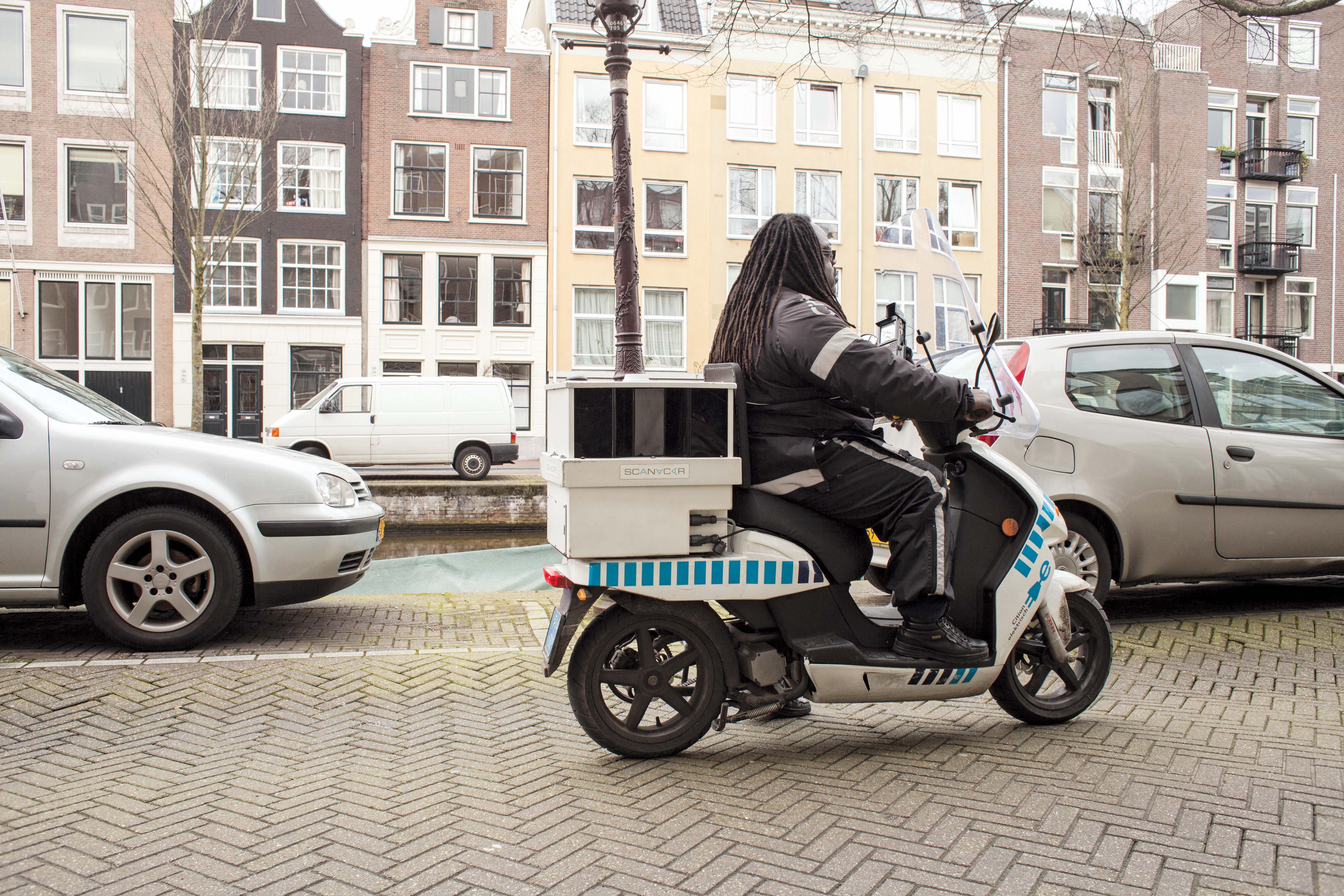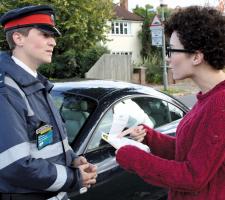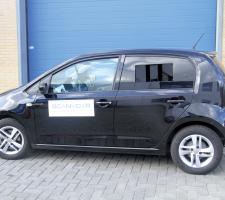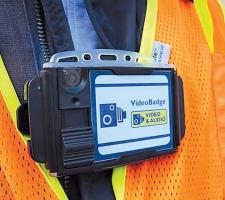
A lower specification system fits onto theback of a scooter
Colin Sowman discovers how the latest systems can boost productivity and reduce conflict in parking enforcement.
Parking enforcement is something of a ‘Cinderella’ service for local authorities: while necessary to keep the roads open and the traffic flowing, it is an expensive operation and can be loss-making. It is also labour intensive and parking enforcement officers are routinely verbally abused and sometimes physically attacked. Some authorities are now looking to automate parking enforcement in order to improve productivity and remove staff from potentially hazardous situations. In the Netherlands the authorities in Amsterdam, Utrecht and Haarlem are using7622 SCANaCAR’s drive-by parking enforcement system which can remove the need for staff members to walk the streets issuing tickets.
As the host vehicle is driven down the road at speeds of up to 100km/h, the onboard system combines high accuracy (sub-350mm) GPS and machine vision-based detection techniques to determine if the vehicles it is passing are legitimately parked. This not only keeps staff away from potentially threatening situations, it is also highly efficient with one person able to check an average of 1,500 vehicles per hour and up to 2,500 an hour in areas with dense parking on both sides of the road.
According to SCANaCAR’s sales and marketing manager Coen Borren, the number plate recognition system has been adapted to read the plates at acute angles. With the host car travelling at 50km/h or less, there only need be a 40cm gap between vehicles parked nose-to-tail for the system to read the plates – and it can do this on both sides of the street simultaneously.
SCANaCAR can also enforce other violations such as parking on pavements or in other restricted areas (which can be particularly time-consuming) to further relieve the load on parking and law enforcement officers.
Once the system has defined a vehicle’s registration number, it encrypts the details and sends it via a 3G service to the relevant authority’s central server while also photographing a contextual view of the vehicle and its registration plate. To determine if it is legitimately parked the authority’s back office system CROSS checks each vehicle’s details against a number of databases including pay-by-phone, company/resident/visitor parking permits and a register of vehicles with disability rights.
Should the vehicle not appear on any of these databases the back office system sends a message requesting a data file for the offending vehicle including date, time, position and images. This information is again encrypted and transmitted back to the authority.
“This complete process usually takes a few minutes depending on the availability of the 3G service and from that point onwards all the evidence is stored on the authority’s central servers. Details of legitimately parked vehicles are wiped from the memory soon after the SCANaCAR’s ignition is turned off,” Borren says.
Enforcement of short stay parking can be done onboard by driving down the same restricted road at the prescribed intervals and in this instance only details of overstay vehicles are sent to the authority.
To comply with their domestic regulations, some authorities may need to send an alert to the nearest parking attendant to visit offending vehicles to carry out a visual check and issue a penalty notice. Others may be able to work with the information already available and, after a grace period for the drivers in the process of paying, directly issue a penalty notice to the registered owner.
The equipment (which seven years ago filled a van) fits into a small hatchback car with the cameras and other items mounted in special panels that replace the rear side-windows. All the electronics are placed in the vehicle’s boot and analyse six times 120 images per second, while the GPS antenna sits on the roof.
Borren: “This allows authorities to use their preferred vehicles and enables suitably equipped authorities to fit the equipment themselves - which only takes one day to install and another to test. It is much easier than trying to import an instrumented vehicle.”
A lower specification version mounts on a scooter so that enforcement personnel do not add to the congestion. Beyond enforcement, the system can also detect vacant parking spaces in real time and transmit that information to the authority for display on the local driver information systems.
In parking enforcement terms, the efficiency of the system is extremely high. In Amsterdam the authorities have a fleet of eight cars and two scooters giving it the capacity to check each of the city’s 140,000 parking spaces once or twice a day.
“In Western European countries you could get a scooter and a car fitted with our equipment for the equivalent cost [including holidays and social costs] of employing two parking attendants for a year,” says Borren.
However, automated parking enforcement has not received a universal welcome everywhere and the UK is contemplating a ban on the use of CCTV enforcement of parking regulations leaving parking attendants as the only option. This leaves open the possibility of conflict between the enforcement officer and aggrieved members of the public. To counter this potential hazard, some authorities are turning to body-worn video cameras to either dissuade members of the public from abusing parking attendants or providing evidence for a prosecution if an assault does take place.
According to Richie McBride, CEO of7621 Edesix which produces the VideoBadge2, parking authorities were the First adopters of this technology – and not without reason: “Every day parking attendants somewhere suffer verbal abuse and over the course of a year some will receive injuries requiring medical treatment.” A big part of the success is to let any members of the public approaching parking attendants or other public services know that they may be being recorded.
Some authorities choose to attach a clearly-visible CCTV symbol on the front of the unit.
“We always suggest a verbal warning is given and that may be enough to deter many people who otherwise may have been tempted to verbally or physically abuse the parking attendant,” says McBride adding: “It is clearly better to stop an abuse happening than to simply collect evidence for a prosecution.”
The VideoBadge2 has a 150o viewpoint, is rapidly activated and has an eight-hour recording time and battery life (72 hours on standby). It measures 10cm x 8cm x 3cm, weighs 130g and can be clipped directly to clothing, attached to a bespoke harness or mounted in a vehicle. As it is not always clear at the outset when trouble may flare, the VideoBadge2 can be configured to record continuously with a user-defined overwrite period (typically five to 15 minutes). So when the record button is pressed the system records onto fresh memory without overwriting the previous five to 15 minutes of materialHe cites the example of Derek Musto, parking manager at Broxtowe Borough Council who attributes improved staff safety and a 40% reduction in serious incidents to the Videobadge which he sees as value for money and an excellent investment.
In order to comply with data protection legislation, the data is encrypted before storage and is automatically downloaded at the end of each shift when the unit is returned to the docking/charging station.
All video evidence is date and time stamped and the back office system can assemble this into evidence packs for prosecution.
In addition to preventing abuse and enabling prosecution of abusers, the availability of video evidence can also cut the cost of resolving disputed parking penalty tickets. According to McBride, this feature alone can make the purchase of body-worn video cost-effective.
It is also extremely useful if a parking attendant (or other wearer) is accused of wrongdoing. “The system records who said what and when as well as showing exactly what each person did or did not do, so it is a powerful tool to get to the truth,” concludes McBride.
Automated enforcement
Automated parking enforcement is something of a touchstone for politicians. For instance the UK looks set to ban local authorities from using CCTV to enforce parking regulations after an intervention by Secretary of State for Communities and Local Government Eric Pickles. This follows an independent review which concluded that ‘aggressive parking policies are harming local high streets and local shops’.
A recent report from pressure group Big Brother Watch says the number of CCTV cars in operation in the UK has increased by 87% since 2009. Furthermore, the4961 RAC Foundation found that only 15% of the UK’s local authorities lost money on enforcement with two councils making a surplus in excess of £30m ($50m). In announcing a review into parking and parking enforcement Pickles said: “We want to rein [-in] over-zealous parking enforcement, so it focuses on supporting high streets and motorists, not raising money. Parking spy cars are just one example of this and a step too far. Public confidence is strengthened in CCTV if it is used to tackle crime, not to raise money for council coffers.”
Parking enforcement is something of a ‘Cinderella’ service for local authorities: while necessary to keep the roads open and the traffic flowing, it is an expensive operation and can be loss-making. It is also labour intensive and parking enforcement officers are routinely verbally abused and sometimes physically attacked. Some authorities are now looking to automate parking enforcement in order to improve productivity and remove staff from potentially hazardous situations. In the Netherlands the authorities in Amsterdam, Utrecht and Haarlem are using
As the host vehicle is driven down the road at speeds of up to 100km/h, the onboard system combines high accuracy (sub-350mm) GPS and machine vision-based detection techniques to determine if the vehicles it is passing are legitimately parked. This not only keeps staff away from potentially threatening situations, it is also highly efficient with one person able to check an average of 1,500 vehicles per hour and up to 2,500 an hour in areas with dense parking on both sides of the road.
According to SCANaCAR’s sales and marketing manager Coen Borren, the number plate recognition system has been adapted to read the plates at acute angles. With the host car travelling at 50km/h or less, there only need be a 40cm gap between vehicles parked nose-to-tail for the system to read the plates – and it can do this on both sides of the street simultaneously.
SCANaCAR can also enforce other violations such as parking on pavements or in other restricted areas (which can be particularly time-consuming) to further relieve the load on parking and law enforcement officers.
Once the system has defined a vehicle’s registration number, it encrypts the details and sends it via a 3G service to the relevant authority’s central server while also photographing a contextual view of the vehicle and its registration plate. To determine if it is legitimately parked the authority’s back office system CROSS checks each vehicle’s details against a number of databases including pay-by-phone, company/resident/visitor parking permits and a register of vehicles with disability rights.
Should the vehicle not appear on any of these databases the back office system sends a message requesting a data file for the offending vehicle including date, time, position and images. This information is again encrypted and transmitted back to the authority.
“This complete process usually takes a few minutes depending on the availability of the 3G service and from that point onwards all the evidence is stored on the authority’s central servers. Details of legitimately parked vehicles are wiped from the memory soon after the SCANaCAR’s ignition is turned off,” Borren says.
Enforcement of short stay parking can be done onboard by driving down the same restricted road at the prescribed intervals and in this instance only details of overstay vehicles are sent to the authority.
To comply with their domestic regulations, some authorities may need to send an alert to the nearest parking attendant to visit offending vehicles to carry out a visual check and issue a penalty notice. Others may be able to work with the information already available and, after a grace period for the drivers in the process of paying, directly issue a penalty notice to the registered owner.
The equipment (which seven years ago filled a van) fits into a small hatchback car with the cameras and other items mounted in special panels that replace the rear side-windows. All the electronics are placed in the vehicle’s boot and analyse six times 120 images per second, while the GPS antenna sits on the roof.
Borren: “This allows authorities to use their preferred vehicles and enables suitably equipped authorities to fit the equipment themselves - which only takes one day to install and another to test. It is much easier than trying to import an instrumented vehicle.”
A lower specification version mounts on a scooter so that enforcement personnel do not add to the congestion. Beyond enforcement, the system can also detect vacant parking spaces in real time and transmit that information to the authority for display on the local driver information systems.
In parking enforcement terms, the efficiency of the system is extremely high. In Amsterdam the authorities have a fleet of eight cars and two scooters giving it the capacity to check each of the city’s 140,000 parking spaces once or twice a day.
“In Western European countries you could get a scooter and a car fitted with our equipment for the equivalent cost [including holidays and social costs] of employing two parking attendants for a year,” says Borren.
However, automated parking enforcement has not received a universal welcome everywhere and the UK is contemplating a ban on the use of CCTV enforcement of parking regulations leaving parking attendants as the only option. This leaves open the possibility of conflict between the enforcement officer and aggrieved members of the public. To counter this potential hazard, some authorities are turning to body-worn video cameras to either dissuade members of the public from abusing parking attendants or providing evidence for a prosecution if an assault does take place.
According to Richie McBride, CEO of
Some authorities choose to attach a clearly-visible CCTV symbol on the front of the unit.
“We always suggest a verbal warning is given and that may be enough to deter many people who otherwise may have been tempted to verbally or physically abuse the parking attendant,” says McBride adding: “It is clearly better to stop an abuse happening than to simply collect evidence for a prosecution.”
The VideoBadge2 has a 150o viewpoint, is rapidly activated and has an eight-hour recording time and battery life (72 hours on standby). It measures 10cm x 8cm x 3cm, weighs 130g and can be clipped directly to clothing, attached to a bespoke harness or mounted in a vehicle. As it is not always clear at the outset when trouble may flare, the VideoBadge2 can be configured to record continuously with a user-defined overwrite period (typically five to 15 minutes). So when the record button is pressed the system records onto fresh memory without overwriting the previous five to 15 minutes of materialHe cites the example of Derek Musto, parking manager at Broxtowe Borough Council who attributes improved staff safety and a 40% reduction in serious incidents to the Videobadge which he sees as value for money and an excellent investment.
In order to comply with data protection legislation, the data is encrypted before storage and is automatically downloaded at the end of each shift when the unit is returned to the docking/charging station.
All video evidence is date and time stamped and the back office system can assemble this into evidence packs for prosecution.
In addition to preventing abuse and enabling prosecution of abusers, the availability of video evidence can also cut the cost of resolving disputed parking penalty tickets. According to McBride, this feature alone can make the purchase of body-worn video cost-effective.
It is also extremely useful if a parking attendant (or other wearer) is accused of wrongdoing. “The system records who said what and when as well as showing exactly what each person did or did not do, so it is a powerful tool to get to the truth,” concludes McBride.
Automated enforcement
Automated parking enforcement is something of a touchstone for politicians. For instance the UK looks set to ban local authorities from using CCTV to enforce parking regulations after an intervention by Secretary of State for Communities and Local Government Eric Pickles. This follows an independent review which concluded that ‘aggressive parking policies are harming local high streets and local shops’.
A recent report from pressure group Big Brother Watch says the number of CCTV cars in operation in the UK has increased by 87% since 2009. Furthermore, the














